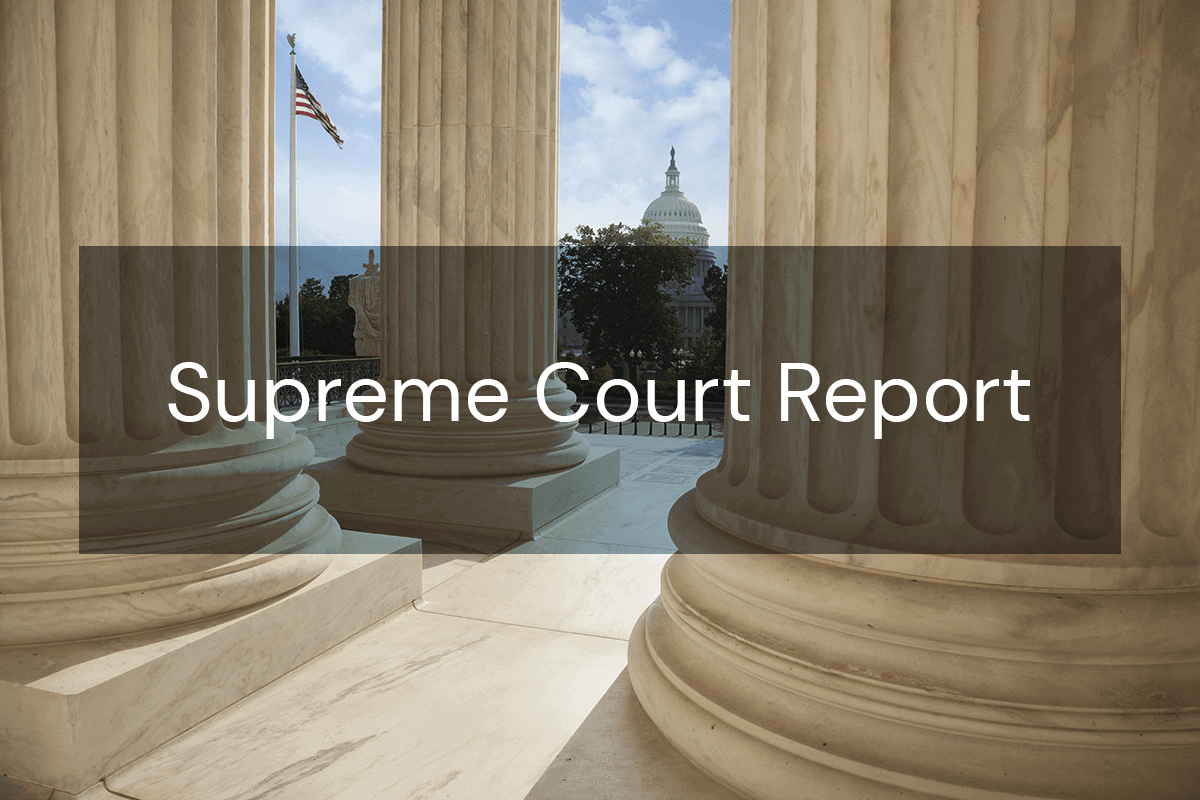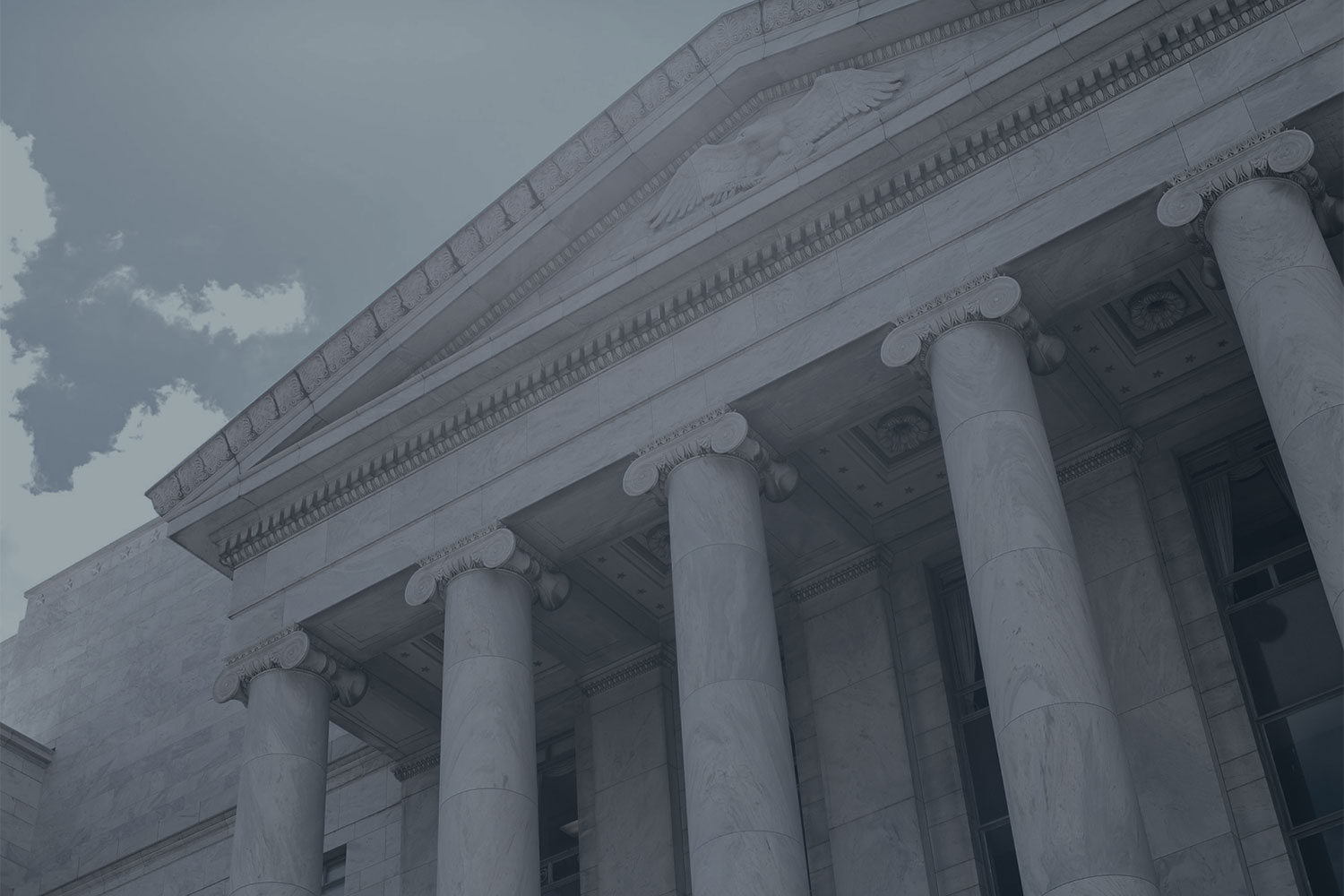-
 Director, Center for Supreme Court AdvocacyNational Association of Attorneys General
Director, Center for Supreme Court AdvocacyNational Association of Attorneys General

This Report summarizes an opinion issued on December 10, 2021 (Part I); and cases granted review on December 10 and 15, 2021 (Part II).
Cases Granted Review: Whole Women’s Health v. Jackson, 21-463
Whole Women’s Health v. Jackson, 21-463. Texas Senate Bill 8 prohibits abortions after roughly six weeks of pregnancy and authorizes only private individuals to enforce the ban. At issue here was whether private plaintiffs could seek pre-enforcement review in federal court. By an 8-1 vote, the Court held that the plaintiffs could do so by suing four executive licensing officials “who may or must take enforcement actions against the petitioners if they violate the terms of Texas’s Health and Safety Code, including S.B. 8.” But the Court, by a 5-4 vote, held that the plaintiffs could not sue any other Texas state official, including the state attorney general and state court clerks and judges. A group of abortion providers filed a pre-enforcement action in federal court alleging that S.B. 8 violates the Constitution and seeking an injunction against various state officials and one private party. Texas moved to dismiss, asserting (among other things) sovereign immunity. After the district court denied the motions to dismiss, the Fifth Circuit issued an order staying proceedings in district court until it could resolve the defendants’ appeals. The Supreme Court refused to grant emergency injunctive relief staying enforcement of S.B. 8, but it then granted certiorari before judgment to resolve defendants’ interlocutory appeals. In an opinion by Justice Gorsuch, the Court held that, at least at the motion to dismiss stage, the federal case could proceed against the four licensing officials, but not against any of the other named defendants. (Eight Justices―all but Justice Thomas―agreed that the case could proceed against the four licensing officials; five Justices―Justices Gorsuch, Thomas, Alito, Kavanaugh, and Barrett―held that the case could not proceed against any other named defendant.)
The Court first held that sovereign immunity bars the federal action against the named state-court judge and state-court clerk. The Court noted that Ex parte Young, 209 U.S. 123 (1908), explained that its exception to sovereign immunity “does not normally permit federal courts to issue injunctions against state-court judges or clerks. Usually those individuals do not enforce state laws as executive officials might; instead, they work to resolve disputes between parties.” Further, judges and clerks are not adverse to petitioners. Clerks simply file cases; judges resolve legal controversies, “not to wage battle as contestants in the parties’ litigation.” Next, there is the problem of remedy. “The petitioners have pointed to nothing in Texas law that permits clerks to pass on the substance of the filings they docket―let alone refuse a party’s complaint based on its assessment of the merits.” The Court also found that petitioners’ theory lacks a limiting principle: if this case could proceed against state judges and clerks, “what would stop federal judges from prohibiting state courts and clerks from hearing and docketing disputes between private parties under other state laws.” Nor, held the Court, could the Texas attorney general be enjoined. “[P]etitioners do not direct this Court to any enforcement authority the attorney general possesses in connection with S.B. 8 that a federal court might enjoin him from exercising.” And responding to Justice Sotomayor’s dissent, which would justify enjoining the attorney general because Texas in S.B. 8 has “delegat[ed] its enforcement authority to the world at large,” the Court said that “somewhat analogous complaints could be levied against private attorneys general acts, statutes allowing for private rights of action, tort law, federal antitrust law, and even the Civil Rights Act of 1964.”
The Court next held that petitioners’ claim for relief can survive against the executive directors of the Texas Medical Board, Texas Board of Nursing, and Texas Board of Pharmacy, and the executive commissioner of the Texas Health and Human Services Commission. The Court stated that “[e]ach of these individuals is an executive licensing official who may or must take enforcement actions against the petitioners if they violate the terms of Texas’s Health and Safety Code, including S.B. 8.” The Court acknowledged that S.B. 8 says that it is to be “exclusively” enforced through private civil actions “[n]otwithstanding . . . any other law.” But, observed the Court, S.B. 8 also provides that the law “may not be construed to . . . limit the enforceability of any other laws that regulate or prohibit abortion.” The Court found this saving clause “significant” because it appears that “the licensing-official defendants are charged with enforcing ‘other laws that regulate . . . abortion,’” including S.B. 8. The Court noted that it reaches this conclusion “based on the limited arguments put to us at this stage of the litigation,” and that “Texas courts and not this one are the final arbiters of the meaning of state statutory directions.”
After finding that even petitioners no longer seriously pursue relief against the one named private defendant, the Court responded to Justice Sotomayor’s contention that the “Court is ‘shrink[ing]’ from the task of defending the supremacy of the Federal Constitution.” “That rhetoric,” said the Court, “bears no relation to reality.” The Court stated that “everyone acknowledges that other pre-enforcement challenges may be possible in state court as well,” and that “any individual sued under S.B. 8 may pursue state and federal constitutional arguments in his or her defense.” The Court emphasized that it “has never recognized an unqualified right to pre-enforcement review of constitutional claims in federal court,” and that §1983 actions were not common until the mid-20th century. Citing a Free Speech Clause case, the Court added that, “[t]o this day, many federal constitutional rights are as a practical matter asserted typically as defenses to state-law claims, not in federal pre-enforcement cases like this one.” And the Court found nothing exceptional about the contention that S.B. 8 might “chill” the exercise of federal constitutional rights. Citing Younger v. Harris, 401 U.S. 37 (1971), the Court stated that its “cases explain” that “the ‘chilling effect’ associated with a potentially unconstitutional law being ‘on the books’ is insufficient to ‘justify federal intervention’ in a pre-enforcement suit.” The Court closed this discussion by insisting that “one thing this Court may never do is disregard the traditional limits on the jurisdiction of federal courts just to see a favored result win the day. At the end of that road is a world in which ‘[t]he division of power’ among the branches of Government ‘could exist no longer, and the other departments would be swallowed up by the judiciary.’ 4 Papers of John Marshall 95 (C. Cullen ed. 1984).”
Justice Thomas issued an opinion concurring in part and dissenting in part. He would hold that petitioners could not maintain their action against any of the defendants. As to the executive licensing officials, he found S.B. 8 “triply clear” that it “explicitly denies enforcement authority to any governmental official.” With regard to the saving clause, Justice Thomas would read the statute “as a ‘harmonious whole’” and find that the saving clause does not authorize the licensing officials to enforce S.B. 8. Rather, said Justice Thomas, the saving clause preserves enforcement only of laws that “regulate or prohibit abortion,” such as restrictions on partial-birth abortions. By contrast, the provision of the Texas Occupations Code enforced by the licensing officials “does not ‘regulate or prohibit abortion’”; it “merely grants authority to the Texas Medical Board to enforce other laws that do regulate abortion.” “Thus,” maintained Justice Thomas, “the saving clause does not apply, and S.B. 8 explicitly forecloses enforcement of its requirements by the Texas Medical Board.” He added that “none of the licensing officials has threatened enforcement proceedings against petitioners because none has authority to bring them.”
Chief Justice Roberts filed an opinion concurring in the judgment in part and dissenting in part, which Justices Breyer, Sotomayor, and Kagan joined. He stated at the outset that “Texas has passed a law banning abortion after roughly six weeks of pregnancy,” in direct contravention of Roe v. Wade, 410 U.S. 113 (1973), and Planned Parenthood of Southeastern Pa. v. Casey, 505 U.S. 833 (1992). “Texas,” said the Chief Justice, “has employed an array of stratagems designed to shield its unconstitutional law from judicial review.” Among other things, “the law authorizes ‘[a]ny person,’ other than a government official, to bring a lawsuit against anyone who ‘aids or abets,’ or intends to aid or abet, an abortion performed after roughly six weeks; has special preclusion rules that allow multiple lawsuits concerning a single abortion; and contains broad venue provisions that allow lawsuits to be brought in any of Texas’s 254 far flung counties, no matter where the abortion took place. The law then provides for minimum liability of $10,000 plus costs and fees, while barring defendants from recovering their own costs and fees if they prevail. It also purports to impose backward-looking liability should this Court’s precedents or an injunction preventing enforcement of the law be overturned. And it forbids many state officers from directly enforcing it. These provisions, among others, effectively chill the provision of abortions in Texas.” (Citations omitted.)
Chief Justice Roberts would have found that, “under Texas law, the Attorney General maintains authority coextensive with the Texas Medical Board to address violations of S.B. 8. The Attorney General may ‘institute an action for a civil penalty’ if a physician violates a rule or order of the Board.” And although state-court clerks “do not ‘usually’ enforce a State’s laws,” “by design the mere threat of even unsuccessful suits brought under S.B. 8 chills constitutionally protected conduct, given the peculiar rules that the State has imposed. Under these circumstances, the court clerks who issue citations and docket S.B. 8 cases are unavoidably enlisted in the scheme to enforce S.B. 8’s unconstitutional provisions, and thus are sufficiently ‘connect[ed]’ to such enforcement to be proper defendants.” Chief Justice Roberts pointed to decisions after Ex parte Young which “recognized that suits to enjoin state court proceedings may be proper,” and that “this conclusion is consistent with the entire thrust of Young itself.” He added that “[a]ny novelty in this remedy is a direct result of the novelty of Texas’s scheme.” Chief Justice Roberts closed by saying that “[t]he clear purpose and actual effect of S. B. 8 has been to nullify this Court’s rulings. It is, however, a basic principle that the Constitution is the ‘fundamental and paramount law of the nation,’ and ‘[i]t is emphatically the province and duty of the judicial department to say what the law is.’ Marbury v. Madison, 1 Cranch 137, 177 (1803). . . . The nature of the federal right infringed does not matter; it is the role of the Supreme Court in our constitutional system that is at stake.”
Justice Sotomayor also wrote an opinion concurring in the judgment in part and dissenting in part, which Justices Breyer and Kagan joined. She began by observing that “[f]or nearly three months, the Texas Legislature has substantially suspended a constitutional guarantee: a pregnant woman’s right to control her own body. . . . The chilling effect has been near total. . . . The Court should have put an end to this madness months ago, before S.B. 8 first went into effect.” She insisted that, “[b]y foreclosing suit against state-court officials and the state attorney general, the Court effectively invites other States to refine S.B. 8’s model for nullifying federal rights. The Court thus betrays not only the citizens of Texas, but also our constitutional system of government.”
Justice Sotomayor maintained that S.B. 8 makes state-court litigation “uniquely punitive for those sued,” and therefore “prevent[s] providers from seeking effective pre-enforcement relief (in both state and federal court) while simultaneously depriving them of effective post-enforcement adjudication.” She said that in cases such as Ex parte Young, the Court has “proven equal to th[e] challenges” of “State attempts to evade constitutional commands.” But not here. Justice Sotomayor would find that state-court clerks are proper defendants here because (quoting Shelley v. Kraemer, 334 U.S. 1 (1948)) the “Court has long recognized that ‘the action of state courts and judicial officers in their official capacities is to be regarded as the action of the State.’” And she cited more recent cases that have allowed suits against state-court judges to proceed. Justice Sotomayor closed by saying, “[m]y disagreement with the Court runs far deeper than a quibble over how many defendants these petitioners may sue. The dispute is over whether States may nullify federal constitutional rights by employing schemes like the one at hand. The Court indicates that they can, so long as they write their laws to more thoroughly disclaim all enforcement by state officials, including licensing officials.” She went on to call S.B. 8 “a brazen challenge to our federal structure” in the vein of “the philosophy of John C. Calhoun.” All told, Justice Sotomayor insisted, “the Court leaves all manner of constitutional rights more vulnerable than ever before, to the great detriment of our Constitution and our Republic.”
[Editor’s note: Some of the language in the background section of the summary above was taken from the petition for writ of certiorari and brief in opposition.]



